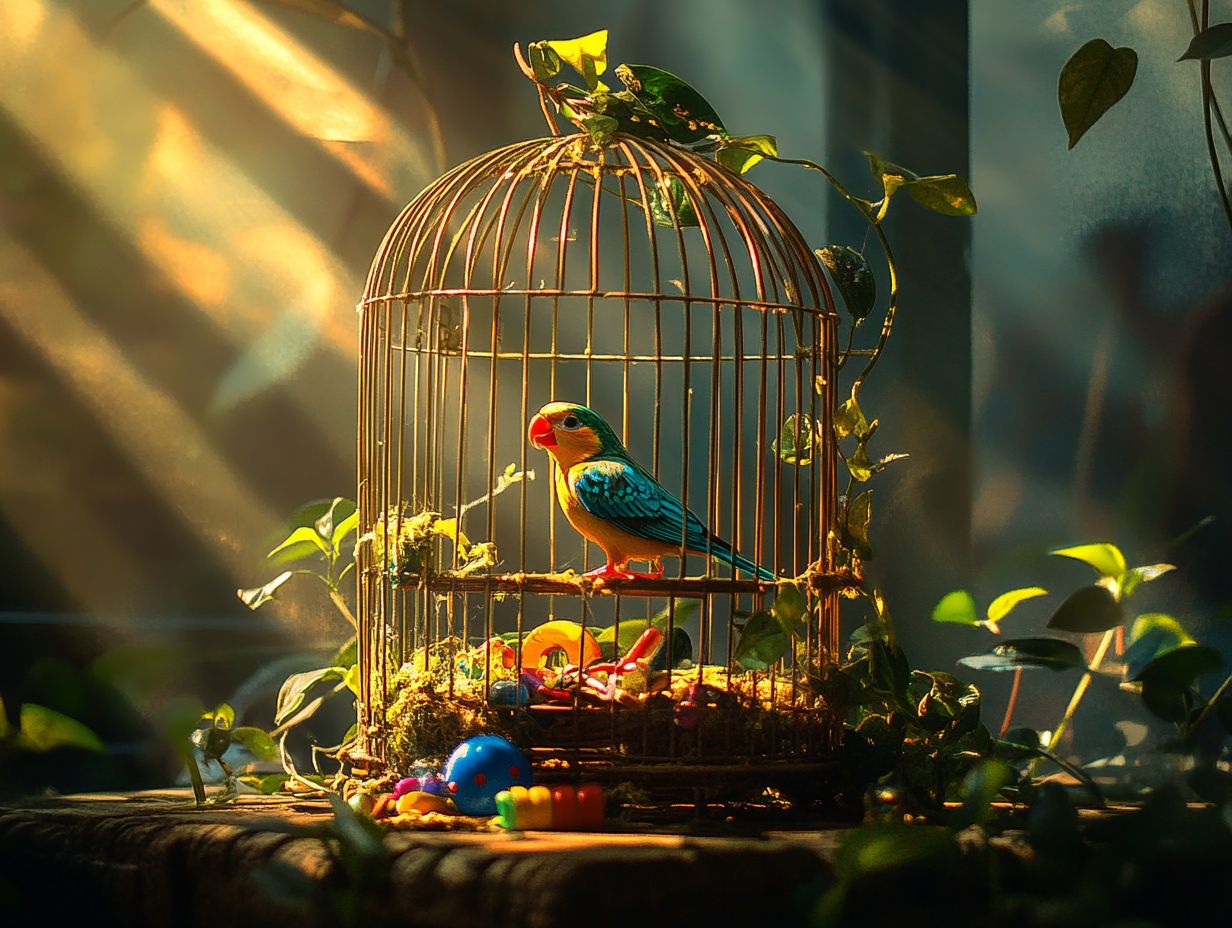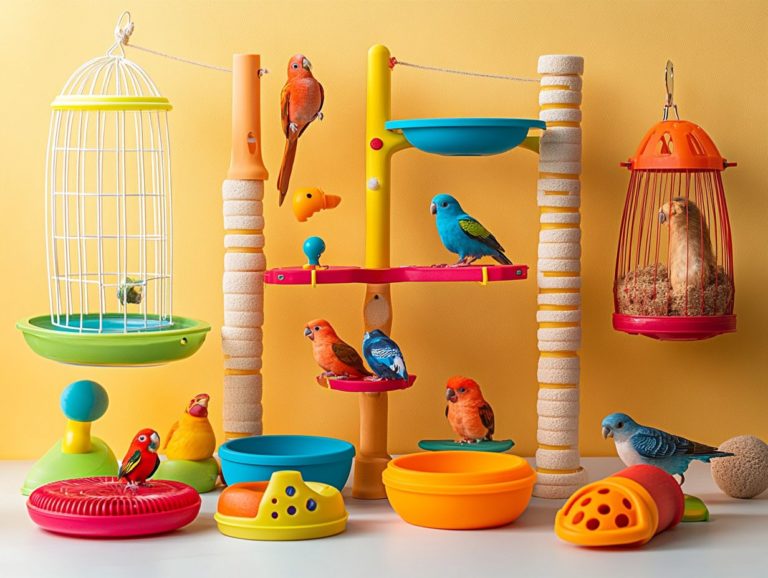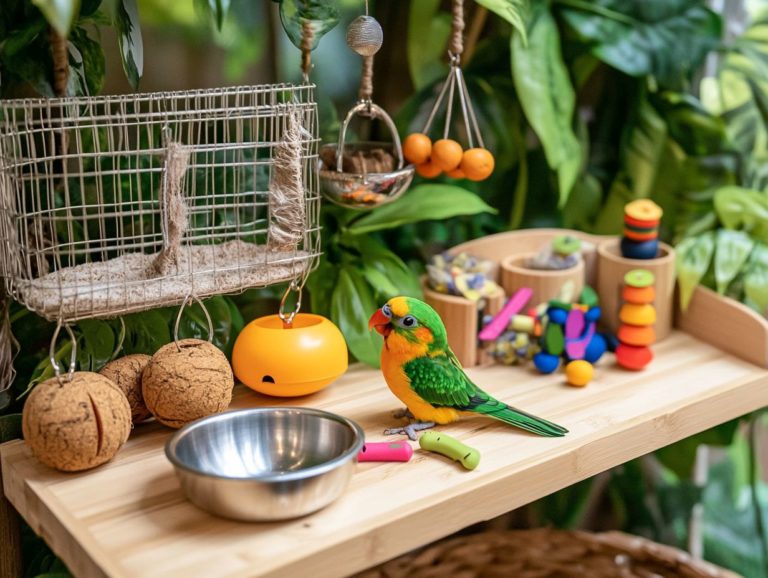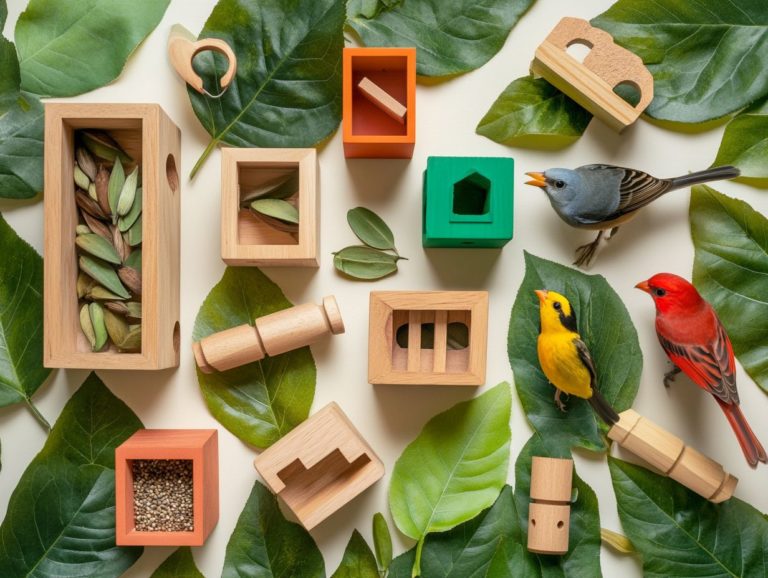How to Make Your Bird’s Cage More Inviting
Creating a warm and nurturing environment for your feathered companions is essential for their happiness and overall well-being, especially when considering their need for a safe and quiet home.
From selecting the ideal cage to understanding their unique needs, every detail significantly influences your birds’ comfort. Providing space for exploration and movement is particularly important.
This guide will unlock the secrets to your birds’ happiness, covering aspects like cage size and materials, the importance of cleanliness, and strategies for a seamless transition into their new home. This ensures your pet birds feel comfortable and secure.
You ll find effective ways to keep your bird engaged, active, and free from common behavior issues through play and interaction.
Immerse yourself in this knowledge to ensure your avian companions flourish in a vibrant and inviting space, creating a sanctuary that feels like home.
Contents
- Key Takeaways:
- Understanding Your Birds’ Needs
- Choosing the Right Cage
- Creating a Comfortable Environment
- Keeping the Cage Clean and Hygienic
- Introducing Your Bird to the Cage
- Encouraging Play and Exercise
- Addressing Common Behavior Issues
- Frequently Asked Questions
- Want to create a cozy haven for your bird? Here s how!
- What types of perches should I add to my bird’s cage?
- What types of toys should I include in my bird’s cage?
- How can I incorporate natural elements into my bird’s cage?
- How often should I clean my bird’s cage?
- Why is it important to regularly change my bird’s food and water?
Key Takeaways:

- Understand your bird’s needs by considering size, material, and features when choosing the right cage.
- Keep your bird’s cage clean and hygienic to promote a healthy environment. Regular cleaning is important for preventing behavior issues and promoting overall well-being.
- Encourage play and exercise by providing perches, toys, and accessories in the cage. Finding the right balance is key to keeping your birds physically and mentally stimulated.
Understanding Your Birds’ Needs
Understanding your birds’ needs is crucial for cultivating a happy and healthy environment that promotes proper development and interaction. As a devoted owner of cockatiels, Congo African Grey Parrots, or Indian Ring Neck Parrots, you must appreciate the unique requirements of these social creatures.
Considerations such as their habitat, feeding habits, and the essential need for companionship significantly influence their well-being. This awareness enriches the lives of your feathered companions and deepens the bond between you, enhancing your overall experience as a bird owner.
Important Things to Keep in Mind
When caring for your pet birds, several key factors ensure their health and happiness.
Social interaction is crucial; these delightful creatures thrive on companionship and stimulation, so engaging with them regularly is a must. Incorporating suitable feeding practices is equally important, as a balanced diet can significantly impact their physical health and longevity.
Effective training methods are essential for nurturing a positive bond and fostering good behavior. To create a comfortable living space, provide toys that challenge their intellect and encourage foraging (searching for food), along with perches of various shapes and sizes to promote exercise.
Regularly assessing their environment helps maintain a harmonious habitat, making them feel secure and enriched. Your commitment to their well-being will reward you with a joyful and vibrant companion.
Choosing the Right Cage
Selecting the right cage for your birds is crucial for crafting a safe and comfortable haven where they can thrive, explore, and socialize. The cage size should be ample enough to allow for movement and play, and the materials must be safe and easy to maintain.
Key features like proper ventilation (ensuring fresh air can circulate in the cage) and accessibility are vital, ensuring your pets enjoy a healthy lifestyle. The ideal cage not only serves as a sanctuary but also enriches the bond between you and your feathered companions.
Size, Material, and Features
The size, material, and features of a bird cage are essential for creating a safe and enriching environment for your birds.
Choosing the right cage size can profoundly influence the well-being of various bird species. Their activity levels and social needs differ widely. For example, a Congo African Grey Parrot demands a more expansive living space due to its high intelligence and need for mental stimulation. Typically, it requires a cage measuring at least 36x24x48 inches. Conversely, cockatiels thrive in a slightly smaller yet still roomy setup, needing around 24x18x24 inches.
Select materials like powder-coated metals to ensure durability and safety. Using non-toxic paints and finishes enhances your birds’ comfort. Features like adjustable perches, multiple doors, and ample space for toys and foraging options create a more stimulating and satisfying environment for your avian companions.
Creating a Comfortable Environment

To make your birds truly happy, pay attention to details like perches, toys, and accessories that align with their natural behaviors and needs. Birds such as cockatiels and parrots flourish in spaces that encourage exploration and play. This fosters a sense of security and well-being.
Make sure to include safe materials and design features. These will make your feathered friends feel right at home, enhancing their happiness and longevity.
Perches, Toys, and Accessories
The right combination of perches, toys, and accessories is crucial for crafting a stimulating and comfortable environment for your bird.
These elements enhance their physical well-being and support their mental health by encouraging natural behaviors like climbing, chewing, and foraging. Incorporating a variety of textures and shapes in toys ignites their curiosity and prompts them to explore.
Selecting perches that mimic different surfaces from natural wood to textured platforms stimulates their feet and enhances their overall comfort.
Place toys in various locations to motivate your birds to move around. This creates a dynamic space that fosters interaction and play. Ultimately, these accessories enrich your bird’s life, ensuring they stay active and happy.
Keeping the Cage Clean and Hygienic
Maintaining a clean and hygienic environment for your bird is crucial for their health and well-being. A dirty cage can lead to various health issues. Regular cleaning is essential for your bird’s care.
Establish regular cleaning routines to keep bacteria and parasites at bay. This creates a welcoming space where your feathered friend can thrive. Prioritizing cleanliness ensures that your cockatiel or Congo African Grey Parrot has a safe sanctuary to explore and enjoy.
Importance of Regular Cleaning
Regularly cleaning your bird’s cage is essential for maintaining top-notch hygiene and health standards. This ensures a safe and comfortable living environment for your feathered companion.
This practice prevents the buildup of harmful bacteria and mold. It fosters a healthier atmosphere for your avian friend. A consistent cleaning schedule can significantly boost your bird’s overall well-being, as a dirty environment can lead to respiratory issues and other health complications.
Establish an efficient cleaning routine by setting aside specific days for deep cleaning. Incorporate daily spot checks to clear away waste and uneaten food. Using bird-safe cleaning products is crucial; they help maintain the cage’s integrity without exposing your pet to toxic substances. This creates a thriving and vibrant living space.
Introducing Your Bird to the Cage
Introducing your bird to its new cage is a delicate endeavor. Ensuring a seamless transition is essential for cultivating a strong bond and guaranteeing their comfort.
Birds, such as cockatiels and Indian Ring Neck Parrots, may initially feel apprehensive. It s crucial to take the time to help them acclimate to their new surroundings.
By crafting a welcome environment, you can foster a sense of safety and security for your pet during this significant adjustment period.
Tips for a Smooth Transition

To ensure a seamless transition for your bird into its new cage, consider a few effective strategies that prioritize comfort and interaction.
Introduce their favorite toys and familiar items from their previous environment. This establishes a comforting sense of security.
Incorporating treats can motivate your bird, helping to create positive associations with this new space. Additionally, learning how to use enrichment in bird cages can enhance their experience. Allow your feathered companion to explore the cage at their own pace. This gives them the time they need to acclimate without feeling pressured, fostering friendship and trust.
This gentle approach nurtures trust and minimizes stress during the transition.
Maintaining a calm demeanor throughout this process can significantly enhance your bird s comfort level. This makes it more likely for them to embrace their new home swiftly.
Encouraging Play and Exercise
Encouraging play and exercise is crucial for the physical and mental well-being of your birds. This ensures they remain happy and engaged in their environment.
Offer a diverse selection of toys and interactive activities to foster healthy movement and exploration. This effectively staves off boredom.
Finding the perfect balance is key to keeping your beloved cockatiel or parrot happy and healthy!
Finding the Right Balance
Balancing play and exercise is essential for your pet birds’ happiness and health. An active lifestyle supports their physical well-being and boosts mental stimulation.
To create an enriching environment, integrate activities that encourage flight, climbing, and foraging. For tips on setting up your space, check out how to prepare your home for a new bird. This allows your birds to tap into their natural instincts.
Encourage social interaction with other birds or engaging toys to significantly enhance their overall well-being.
Don t forget that ample rest is just as important. Downtime enables your delightful feathered friends to rejuvenate and gear up for their next playful escapade.
Addressing Common Behavior Issues
Addressing common behavioral issues in pet birds is crucial for a harmonious relationship. Boredom and aggression can manifest in various ways, affecting your bird’s overall well-being.
By gaining insight into these behaviors and employing effective training techniques, you can create a more positive living environment for your cockatiel or parrot.
Dealing with Boredom and Aggression
Dealing with boredom and aggression in your pet birds requires a proactive approach that emphasizes interaction and stimulating toys.
Incorporate a variety of engaging activities to create a dynamic environment that encourages exploration and play. Introduce new toys like puzzle feeders, which are toys that require your bird to solve a problem to get food, and chewable items.
Interactive games like hide-and-seek or fetch stimulate both physical and mental activity.
Use training techniques such as positive reinforcement, which means rewarding good behavior. This strengthens your bond with your bird and reduces undesirable behaviors that stem from boredom.
Regularly rotate toys and integrate learning moments into playtime. This keeps your birds alert and satisfied, leading to happier, more balanced companions.
Frequently Asked Questions

Want to create a cozy haven for your bird? Here s how!
To make your bird’s cage more inviting, add perches, toys, and natural elements like branches and plants. You can also learn how to personalize your bird’s play space to enhance their environment. Regularly clean the cage and provide fresh food and water.
What types of perches should I add to my bird’s cage?
Include different types of perches, such as natural wood perches, rope perches, and cement perches. These varieties help keep your bird’s feet healthy and exercised.
Start making these changes today to see your feathered friend thrive!
What types of toys should I include in my bird’s cage?
Include toys that offer mental and physical challenges, like puzzles, bells, and chew toys. Keep the fun alive by rotating your bird’s toys regularly!
How can I incorporate natural elements into my bird’s cage?
Add branches, plants, and natural materials such as straw or hay. These not only look great but also encourage your bird to search for food and play, following the top 10 tips for bird cage setup.
How often should I clean my bird’s cage?
Clean your bird’s cage at least once a week. This means changing the paper lining, wiping surfaces, and disinfecting the cage.
Clean the food and water bowls daily to prevent bacteria growth.
Why is it important to regularly change my bird’s food and water?
Birds are sensitive to bacteria. Change their food and water regularly to keep it fresh and safe.






